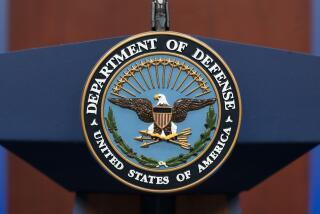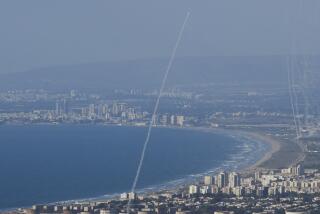U.S. Raises Terrorism Alert Amid Concerns of Retaliation
WASHINGTON â Bracing for a backlash from impending war with Iraq, the Bush administration put the nation on high alert for a terrorist attack and announced that it was redoubling efforts to enhance security at home.
The decision to raise the terrorism threat level from yellow to orange, the third such move in the last six months, followed several months worth of intelligence reports indicating a strong likelihood of some type of terrorist attack or retaliation if the U.S. went to war with Iraq. Those strikes, officials said, could come from organized Al Qaeda cells or groups sent here by Iraqi President Saddam Hussein, or from individuals or small groups who sympathize with them.
The terrorism index was previously boosted to orange, indicating a high risk, for a month last fall -- around the one-year anniversary of the Sept. 11 attacks -- and on Feb. 7 amid a marked increase in terrorist âchatterâ picked up by U.S. intelligence. That triggered a series of measures by state and federal agencies aimed at securing everything from the governmentâs electricity infrastructure to its pharmaceutical stockpile. The level was reduced to yellow, indicating an elevated risk, on Feb. 27.
Late Monday, officials in the Department of Homeland Security charted details of what they said was an even more aggressive response. The initiative, dubbed Operation Liberty Shield, set in motion a vast deployment of law enforcement, health and transportation personnel around the country.
The effort, officials said, was designed to increase security at U.S. borders, protect the transportation industry and computer-based infrastructures, increase public health preparedness and make federal response faster.
The plan was also designed, officials said, to increase protection while maintaining the flow of people and goods across the Canadian and Mexican borders, unlike after the Sept. 11 attacks, when security checkpoints caused huge backlogs.
Homeland Security Secretary Tom Ridge said the decision to raise the terrorism alert was based on assessments by the CIA and others in the intelligence community âthat terrorists will attempt multiple attacks against U.S. and coalition targets worldwide in the event of a U.S.-led military campaignâ against Hussein.
Ridge said the March 1 arrest of senior Al Qaeda operative Khalid Shaikh Mohammed put the terrorist network on the defensive. Nevertheless, he added, âthe intelligence community believes that [Mohammedâs] capture will not necessarily affect operations that are ready or nearly ready for execution. There are many recent indications that Al Qaedaâs planning includes the use of chemical, biological, and/or radiological materials.â
Ridge said that although intelligence reports indicate that Al Qaeda and its sympathizers remain the principal threat, âIraqi state agents, Iraqi surrogate groups, other regional extremist organizations, and ad hoc groups or disgruntled individuals not connected to existing organizations or state agencies may use this time period to conduct terrorist attacks.â
In recent months, there have been reports of suspicious activity in and around military facilities, ports, waterways, bridges, dams and power facilities, as well as targets that are considered symbolic to U.S. power and influence, Ridge said.
FBI officials said the bureau will increase scouting for potential terrorist activity in the U.S. in the event of war, including the monitoring of potentially hundreds of Iraqis who it has determined might cause problems.
Agents already have canvassed communities with a large number of Iraqi expatriates and will continue to question people there âwho might know something, as well as let them know the FBIâs responsibility is to help them if they are the victim of a hate crime,â said an FBI official.
With the elevated alert, the federal Transportation Security Administration also began implementing a heightened security plan at airports, as the airline industry braced for steep declines in bookings and Arab Americans worried about becoming targets of suspicion for merely traveling.
Among the measures are random inspection of vehicles approaching airports, increased visibility of police officers and canine teams, closer checks of delivery trucks at airfield gates and signs to alert the public to be vigilant.
Airline officials said the industry is better protected now than it was in 1991, during the Persian Gulf War. Cockpit doors have been reinforced, air marshals are on hundreds of flights a day and federal screeners are checking passengers and their bags.
Times staff writer Ricardo Alonso-Zaldivar contributed to this report.
More to Read
Sign up for Essential California
The most important California stories and recommendations in your inbox every morning.
You may occasionally receive promotional content from the Los Angeles Times.










